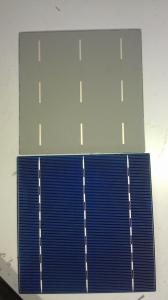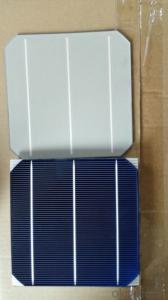Plasmonic Wholesale Poly Solar Cell 156mm x 156mm from China
- Loading Port:
- Shanghai
- Payment Terms:
- TT or LC
- Min Order Qty:
- 6500 watt
- Supply Capability:
- 6000000 watt/month
OKorder Service Pledge
OKorder Financial Service
You Might Also Like
The operation of a photovoltaic (PV) cell requires 3 basic attributes:
The absorption of light, generating either electron-hole pairs or excitons.
The separation of charge carriers of opposite types.
The separate extraction of those carriers to an external circuit.
In contrast, a solar thermal collector supplies heat by absorbing sunlight, for the purpose of either direct heating or indirect electrical power generation from heat. A "photoelectrolytic cell" (photoelectrochemical cell), on the other hand, refers either to a type of photovoltaic cell (like that developed by Edmond Becquerel and modern dye-sensitized solar cells), or to a device that splits water directly into hydrogen and oxygen using only solar illumination.Characteristic of Mono 156X156MM2 Solar Cells
You are gaining energy independence - add battery backup power for even greater energy security
The cost of electricity is only going to rise – insure against that rising cost
Adaptive cells change their absorption/reflection characteristics depending to respond to environmental conditions. An adaptive material responds to the intensity and angle of incident light. At the part of the cell where the light is most intense, the cell surface changes from reflective to adaptive, allowing the light to penetrate the cell. The other parts of the cell remain reflective increasing the retention of the absorbed light within the cell.[67]
In 2014 a system that combined an adaptive surface with a glass substrate that redirect the absorbed to a light absorber on the edges of the sheet. The system also included an array of fixed lenses/mirrors to concentrate light onto the adaptive surface. As the day continues, the concentrated light moves along the surface of the cell. That surface switches from reflective to adaptive when the light is most concentrated and back to reflective after the light moves along
Mechanical data and design
Format | 156mm x 156mm±0.5mm |
Thickness | 210μm±40μm |
Front(-) | 1.5mm bus bar (silver),blue anti-reflection coating (silicon nitride) |
Back (+) | 2.5mm wide soldering pads (sliver) back surface field (aluminium) |
Temperature Coefficient of Cells
Voc. Temp.coef.%/K | -0.35% |
Isc. Temp.coef .%/K | +0.024%/K |
Pm.Temp.coef. %/K | -0.47%/K |
Electrical Characteristic
Effiency(%) | Pmpp(W) | Umpp(V) | Impp(A) | Uoc(V) | Isc(A) | FF(%) |
18.35 | 4.384 | 0.526 | 8.333 | 0.63 | 8.877 | 78.39% |
18.20 | 4.349 | 0.526 | 8.263 | 0.63 | 8.789 | 78.54% |
18.05 | 4.313 | 0.525 | 8.216 | 0.63 | 8.741 | 78.32% |
17.90 | 4.277 | 0.524 | 8.161 | 0.625 | 8.713 | 78.04% |
17.75 | 4.241 | 0.523 | 8.116 | 0.625 | 8.678 | 77.70% |
17.60 | 4.206 | 0.521 | 8.073 | 0.625 | 8.657 | 77.36% |
17.45 | 4.170 | 0.519 | 8.039 | 0.625 | 8.633 | 76.92% |
17.30 | 4.134 | 0.517 | 8.004 | 0.625 | 8.622 | 76.59% |
17.15 | 4.096 | 0.516 | 7.938 | 0.625 | 8.537 | 76.80% |
17.00 | 4.062 | 0.512 | 7.933 | 0.625 | 8.531 | 76.18% |
16.75 | 4.002 | 0.511 | 7.828 | 0.625 | 8.499 | 75.34% |
16.50 | 3.940 | 0.510 | 7.731 | 0.625 | 8.484 | 74.36% |




 FAQ
FAQ
Q: What price for each watt?
A: It depends on the quantity, delivery date and payment terms, generally Large Quantity and Low Price
Q: What is your size for each module? Can you tell me the Parameter of your module?
A: We have different series of panels in different output, both c-Si and a-Si. Please take the specification sheet for your reference.
Q: What is your size for each module? Can you tell me the Parameter of your module?
A: We have different series of panels in different output, both c-Si and a-Si. Please take the specification sheet for your reference.
Poly solar cell 156mm manufacturing process
Cell sorting - Single Welding - string jointing - splicing (the string is welded battery slice positioning, stitching together) - intermediate test (intermediate test points: Infrared testing and visual inspection) - laminated - cutting edge - layer after appearance - after layer infrared - mounted box (usually aluminum frame) - mounted terminal box - cleaning - tests (this link also points infrared testing and visual inspection of the component level determination.) - Packaging.
(1) poly solar cell 156mm test
Because of the randomness of the solar cell manufacturing conditions, produced by the battery performance is different, so in order to effectively identical or similar battery together, it should be classified according to its performance parameters; battery test through the test cell output parameters (current and voltage) of the size of its classification. In order to improve the utilization of the battery, a battery pack made of acceptable quality.
(2) poly solar cell 156mm welding positive
Main gate line, convergence with soldered to the battery positive (negative), the convergence zone for the tinned copper strip, we use a welding machine can weld with a multi-point spot welding in the form of the main gate line. Welding heat source is an infrared lamp (using infrared thermal effect). The length of the ribbon is about 2 times the battery side length. More welding belt behind the back of the welding electrode is connected to the back of the back of the battery slice.
(3) poly solar cell 156mm in series
On the back of the battery is soldered together in series to form a module string, we are currently used process is manual, locate the battery depends mainly on a membrane with plate placement battery film grooves, groove size and battery size phase corresponding to the location of tank has been designed well, different specifications of the components use a different template, the operator use a soldering iron and solder wire will "in front of the battery," the positive electrode (anode) is welded to the "behind the battery" on the back electrode (cathode) this in turn connected in series with the positive and negative components in a string of welding wire.
- Q: How much maintenance do solar cells require?
- Solar cells require very little maintenance. They are designed to be durable and require minimal attention once installed. Regular cleaning to remove dust and debris is recommended, and occasional inspections to ensure proper functioning are advisable. Other than that, solar cells are known for their long lifespan and low maintenance requirements.
- Q: Can solar cells be used on airplanes?
- Yes, solar cells can be used on airplanes. Solar panels can be installed on the wings or fuselage of an aircraft to harness solar energy and convert it into electricity. This can be used to power various onboard systems, reduce reliance on traditional fuel sources, and increase the overall energy efficiency of the aircraft.
- Q: What is a polycrystalline solar cell?
- A polycrystalline solar cell is a type of solar cell made from multiple crystal structures, resulting in a grainy appearance. It is less expensive to produce compared to monocrystalline cells, but typically has lower efficiency levels.
- Q: What are the advantages of monocrystalline silicon and polycrystalline silicon in solar power?
- no mechanical groove in the same area on the efficiency of 16%, using buried gate structure, mechanical groove in the 130 square centimeters of polycrystalline Battery efficiency of 15.8%. (1) monocrystalline silicon solar cells
- Q: Can solar cells be used in smart home automation systems?
- Yes, solar cells can be used in smart home automation systems. Solar cells are used to convert sunlight into electricity, which can then be used to power various devices and systems in a smart home. By integrating solar cells into a smart home automation system, homeowners can reduce their reliance on traditional electricity sources and take advantage of renewable energy, leading to energy efficiency and cost savings. Additionally, solar-powered smart home automation systems can contribute to a more sustainable and environmentally friendly lifestyle.
- Q: How do solar cells perform in areas with high levels of radiation?
- Solar cells perform well in areas with high levels of radiation. The excess radiation actually increases the energy output of the solar cells, allowing them to generate more electricity.
- Q: Can solar cells be used for off-grid living?
- Yes, solar cells can be used for off-grid living. Solar panels can generate electricity from sunlight, which can then be used to power various appliances and devices in a home or building. This eliminates the need for being connected to the traditional power grid, making it a sustainable and independent energy solution for off-grid living.
- Q: Can solar cells be used in telecommunications systems?
- Yes, solar cells can be used in telecommunications systems. Solar cells can generate electricity from sunlight, which can be used to power various components of telecommunications systems such as base stations, repeaters, and communication towers. This reduces reliance on traditional power sources and provides a more sustainable and cost-effective solution. Additionally, solar cells can be easily installed in remote locations where grid power is not available, making them an ideal choice for extending communication networks in rural or off-grid areas.
- Q: How do monocrystalline solar cells differ from polycrystalline solar cells?
- Monocrystalline solar cells are made from a single crystal structure, typically silicon, which allows for higher efficiency and performance in converting sunlight into electricity. On the other hand, polycrystalline solar cells are made from multiple crystal structures, resulting in a lower efficiency but a more cost-effective option.
- Q: What is the window material in the solar cell? what's the effect?
- Because the window layer near the surface, the defect is very much, if the absorption of light generated photogenerated carriers, then it is easy to die, do not contribute to the battery output, the absorption of light are wasted, reducing battery efficiency.
Send your message to us
Plasmonic Wholesale Poly Solar Cell 156mm x 156mm from China
- Loading Port:
- Shanghai
- Payment Terms:
- TT or LC
- Min Order Qty:
- 6500 watt
- Supply Capability:
- 6000000 watt/month
OKorder Service Pledge
OKorder Financial Service
Similar products
Hot products
Hot Searches
Related keywords






























